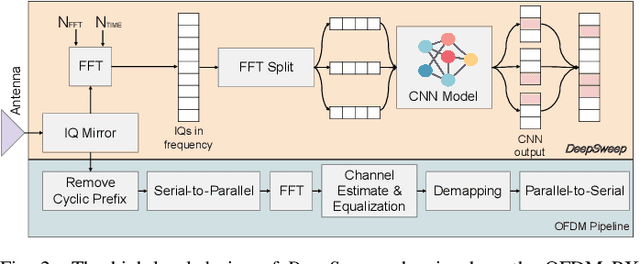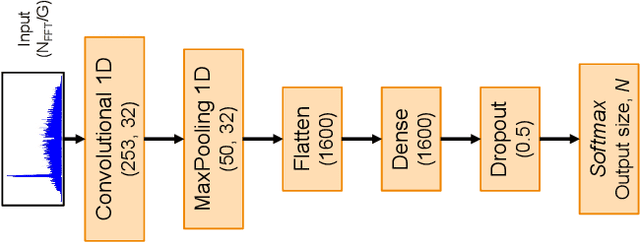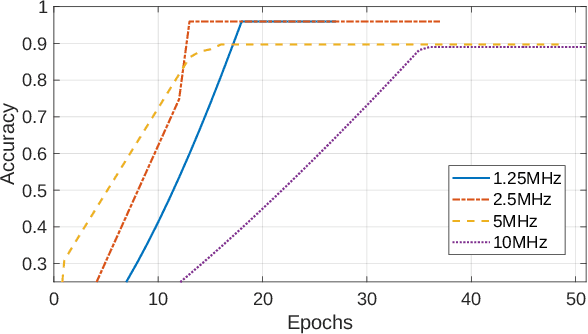Daniel Uvaydov
Stitching the Spectrum: Semantic Spectrum Segmentation with Wideband Signal Stitching
Feb 07, 2024



Abstract:Spectrum has become an extremely scarce and congested resource. As a consequence, spectrum sensing enables the coexistence of different wireless technologies in shared spectrum bands. Most existing work requires spectrograms to classify signals. Ultimately, this implies that images need to be continuously created from I/Q samples, thus creating unacceptable latency for real-time operations. In addition, spectrogram-based approaches do not achieve sufficient granularity level as they are based on object detection performed on pixels and are based on rectangular bounding boxes. For this reason, we propose a completely novel approach based on semantic spectrum segmentation, where multiple signals are simultaneously classified and localized in both time and frequency at the I/Q level. Conversely from the state-of-the-art computer vision algorithm, we add non-local blocks to combine the spatial features of signals, and thus achieve better performance. In addition, we propose a novel data generation approach where a limited set of easy-to-collect real-world wireless signals are ``stitched together'' to generate large-scale, wideband, and diverse datasets. Experimental results obtained on multiple testbeds (including the Arena testbed) using multiple antennas, multiple sampling frequencies, and multiple radios over the course of 3 days show that our approach classifies and localizes signals with a mean intersection over union (IOU) of 96.70% across 5 wireless protocols while performing in real-time with a latency of 2.6 ms. Moreover, we demonstrate that our approach based on non-local blocks achieves 7% more accuracy when segmenting the most challenging signals with respect to the state-of-the-art U-Net algorithm. We will release our 17 GB dataset and code.
SeizNet: An AI-enabled Implantable Sensor Network System for Seizure Prediction
Jan 12, 2024



Abstract:In this paper, we introduce SeizNet, a closed-loop system for predicting epileptic seizures through the use of Deep Learning (DL) method and implantable sensor networks. While pharmacological treatment is effective for some epilepsy patients (with ~65M people affected worldwide), one out of three suffer from drug-resistant epilepsy. To alleviate the impact of seizure, predictive systems have been developed that can notify such patients of an impending seizure, allowing them to take precautionary measures. SeizNet leverages DL techniques and combines data from multiple recordings, specifically intracranial electroencephalogram (iEEG) and electrocardiogram (ECG) sensors, that can significantly improve the specificity of seizure prediction while preserving very high levels of sensitivity. SeizNet DL algorithms are designed for efficient real-time execution at the edge, minimizing data privacy concerns, data transmission overhead, and power inefficiencies associated with cloud-based solutions. Our results indicate that SeizNet outperforms traditional single-modality and non-personalized prediction systems in all metrics, achieving up to 99% accuracy in predicting seizure, offering a promising new avenue in refractory epilepsy treatment.
DeepSweep: Parallel and Scalable Spectrum Sensing via Convolutional Neural Networks
Jan 09, 2024



Abstract:Spectrum sensing is an essential component of modern wireless networks as it offers a tool to characterize spectrum usage and better utilize it. Deep Learning (DL) has become one of the most used techniques to perform spectrum sensing as they are capable of delivering high accuracy and reliability. However, current techniques suffer from ad-hoc implementations and high complexity, which makes them unsuited for practical deployment on wireless systems where flexibility and fast inference time are necessary to support real-time spectrum sensing. In this paper, we introduce DeepSweep, a novel DL-based transceiver design that allows scalable, accurate, and fast spectrum sensing while maintaining a high level of customizability to adapt its design to a broad range of application scenarios and use cases. DeepSweep is designed to be seamlessly integrated with well-established transceiver designs and leverages shallow convolutional neural network (CNN) to "sweep" the spectrum and process captured IQ samples fast and reliably without interrupting ongoing demodulation and decoding operations. DeepSweep reduces training and inference times by more than 2 times and 10 times respectively, achieves up to 98 percent accuracy in locating spectrum activity, and produces outputs in less than 1 ms, thus showing that DeepSweep can be used for a broad range of spectrum sensing applications and scenarios.
Demo: Intelligent Radar Detection in CBRS Band in the Colosseum Wireless Network Emulator
Sep 16, 2023



Abstract:The ever-growing number of wireless communication devices and technologies demands spectrum-sharing techniques. Effective coexistence management is crucial to avoid harmful interference, especially with critical systems like nautical and aerial radars in which incumbent radios operate mission-critical communication links. In this demo, we showcase a framework that leverages Colosseum, the world's largest wireless network emulator with hardware-in-the-loop, as a playground to study commercial radar waveforms coexisting with a cellular network in CBRS band in complex environments. We create an ad-hoc high-fidelity spectrum-sharing scenario for this purpose. We deploy a cellular network to collect IQ samples with the aim of training an ML agent that runs at the base station. The agent has the goal of detecting incumbent radar transmissions and vacating the cellular bandwidth to avoid interfering with the radar operations. Our experiment results show an average detection accuracy of 88%, with an average detection time of 137 ms.
Twinning Commercial Radio Waveforms in the Colosseum Wireless Network Emulator
Aug 18, 2023



Abstract:Because of the ever-growing amount of wireless consumers, spectrum-sharing techniques have been increasingly common in the wireless ecosystem, with the main goal of avoiding harmful interference to coexisting communication systems. This is even more important when considering systems, such as nautical and aerial fleet radars, in which incumbent radios operate mission-critical communication links. To study, develop, and validate these solutions, adequate platforms, such as the Colosseum wireless network emulator, are key as they enable experimentation with spectrum-sharing heterogeneous radio technologies in controlled environments. In this work, we demonstrate how Colosseum can be used to twin commercial radio waveforms to evaluate the coexistence of such technologies in complex wireless propagation environments. To this aim, we create a high-fidelity spectrum-sharing scenario on Colosseum to evaluate the impact of twinned commercial radar waveforms on a cellular network operating in the CBRS band. Then, we leverage IQ samples collected on the testbed to train a machine learning agent that runs at the base station to detect the presence of incumbent radar transmissions and vacate the bandwidth to avoid causing them harmful interference. Our results show an average detection accuracy of 88%, with accuracy above 90% in SNR regimes above 0 dB and SINR regimes above -20 dB, and with an average detection time of 137 ms.
Narrowband Interference Detection via Deep Learning
Jan 23, 2023Abstract:Due to the increased usage of spectrum caused by the exponential growth of wireless devices, detecting and avoiding interference has become an increasingly relevant problem to ensure uninterrupted wireless communications. In this paper, we focus our interest on detecting narrowband interference caused by signals that despite occupying a small portion of the spectrum only can cause significant harm to wireless systems, for example, in the case of interference with pilots and other signals that are used to equalize the effect of the channel or attain synchronization. Due to the small sizes of these signals, detection can be difficult due to their low energy footprint, while greatly impacting (or denying completely in some cases) network communications. We present a novel narrowband interference detection solution that utilizes convolutional neural networks (CNNs) to detect and locate these signals with high accuracy. To demonstrate the effectiveness of our solution, we have built a prototype that has been tested and validated on a real-world over-the-air large-scale wireless testbed. Our experimental results show that our solution is capable of detecting narrowband jamming attacks with an accuracy of up to 99%. Moreover, it is also able to detect multiple attacks affecting several frequencies at the same time even in the case of previously unseen attack patterns. Not only can our solution achieve a detection accuracy between 92% and 99%, but it does so by only adding an inference latency of 0.093ms.
 Add to Chrome
Add to Chrome Add to Firefox
Add to Firefox Add to Edge
Add to Edge